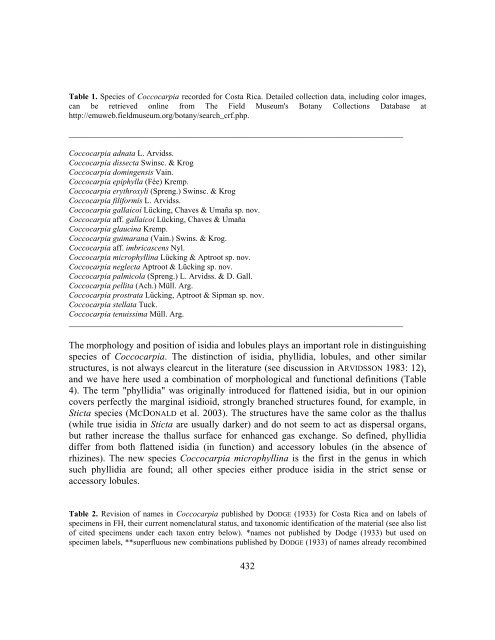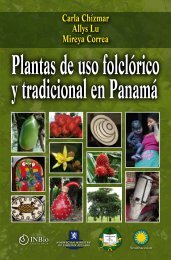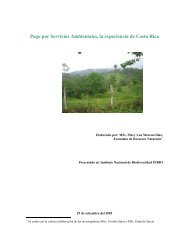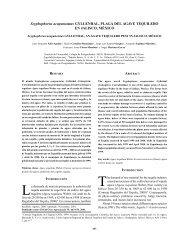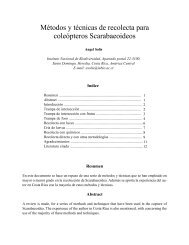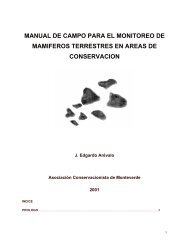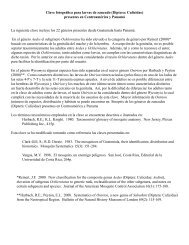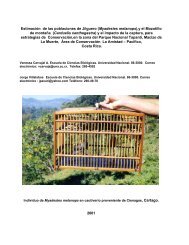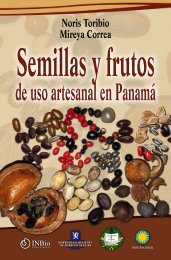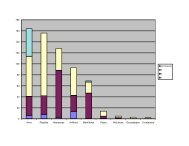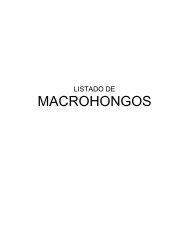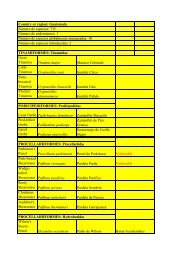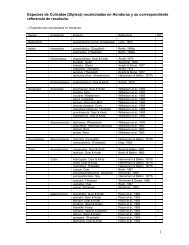the genus Coccocarpia (Peltigerales: Coccocarpiaceae) - Instituto ...
the genus Coccocarpia (Peltigerales: Coccocarpiaceae) - Instituto ...
the genus Coccocarpia (Peltigerales: Coccocarpiaceae) - Instituto ...
Create successful ePaper yourself
Turn your PDF publications into a flip-book with our unique Google optimized e-Paper software.
Table 1. Species of <strong>Coccocarpia</strong> recorded for Costa Rica. Detailed collection data, including color images,<br />
can be retrieved online from The Field Museum's Botany Collections Database at<br />
http://emuweb.fieldmuseum.org/botany/search_crf.php.<br />
__________________________________________________________________________________<br />
<strong>Coccocarpia</strong> adnata L. Arvidss.<br />
<strong>Coccocarpia</strong> dissecta Swinsc. & Krog<br />
<strong>Coccocarpia</strong> domingensis Vain.<br />
<strong>Coccocarpia</strong> epiphylla (Fée) Kremp.<br />
<strong>Coccocarpia</strong> erythroxyli (Spreng.) Swinsc. & Krog<br />
<strong>Coccocarpia</strong> filiformis L. Arvidss.<br />
<strong>Coccocarpia</strong> gallaicoi Lücking, Chaves & Umaña sp. nov.<br />
<strong>Coccocarpia</strong> aff. gallaicoi Lücking, Chaves & Umaña<br />
<strong>Coccocarpia</strong> glaucina Kremp.<br />
<strong>Coccocarpia</strong> guimarana (Vain.) Swins. & Krog.<br />
<strong>Coccocarpia</strong> aff. imbricascens Nyl.<br />
<strong>Coccocarpia</strong> microphyllina Lücking & Aptroot sp. nov.<br />
<strong>Coccocarpia</strong> neglecta Aptroot & Lücking sp. nov.<br />
<strong>Coccocarpia</strong> palmicola (Spreng.) L. Arvidss. & D. Gall.<br />
<strong>Coccocarpia</strong> pellita (Ach.) Müll. Arg.<br />
<strong>Coccocarpia</strong> prostrata Lücking, Aptroot & Sipman sp. nov.<br />
<strong>Coccocarpia</strong> stellata Tuck.<br />
<strong>Coccocarpia</strong> tenuissima Müll. Arg.<br />
__________________________________________________________________________________<br />
The morphology and position of isidia and lobules plays an important role in distinguishing<br />
species of <strong>Coccocarpia</strong>. The distinction of isidia, phyllidia, lobules, and o<strong>the</strong>r similar<br />
structures, is not always clearcut in <strong>the</strong> literature (see discussion in ARVIDSSON 1983: 12),<br />
and we have here used a combination of morphological and functional definitions (Table<br />
4). The term "phyllidia" was originally introduced for flattened isidia, but in our opinion<br />
covers perfectly <strong>the</strong> marginal isidioid, strongly branched structures found, for example, in<br />
Sticta species (MCDONALD et al. 2003). The structures have <strong>the</strong> same color as <strong>the</strong> thallus<br />
(while true isidia in Sticta are usually darker) and do not seem to act as dispersal organs,<br />
but ra<strong>the</strong>r increase <strong>the</strong> thallus surface for enhanced gas exchange. So defined, phyllidia<br />
differ from both flattened isidia (in function) and accessory lobules (in <strong>the</strong> absence of<br />
rhizines). The new species <strong>Coccocarpia</strong> microphyllina is <strong>the</strong> first in <strong>the</strong> <strong>genus</strong> in which<br />
such phyllidia are found; all o<strong>the</strong>r species ei<strong>the</strong>r produce isidia in <strong>the</strong> strict sense or<br />
accessory lobules.<br />
Table 2. Revision of names in <strong>Coccocarpia</strong> published by DODGE (1933) for Costa Rica and on labels of<br />
specimens in FH, <strong>the</strong>ir current nomenclatural status, and taxonomic identification of <strong>the</strong> material (see also list<br />
of cited specimens under each taxon entry below). *names not published by Dodge (1933) but used on<br />
specimen labels, **superfluous new combinations published by DODGE (1933) of names already recombined<br />
432


